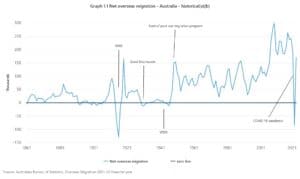Australia’s housing market is set to get even tighter, with projected population growth of 7.4 million expected to drive demand for housing in the country’s largest cities.
According to data from demographic consulting firm Informed Decisions (.id), Sydney, Melbourne, Brisbane and Perth will need a combined 2 million more dwellings to absorb 67% of the forecast population growth by 2041.
Melbourne is projected to add 1.6 million residents, higher than Sydney’s 1.2 million. Brisbane is poised for a population increase of 974,000, while Perth is forecast to gain 979,000 residents. This is largely driven by rising net migration – the difference between the number of people moving to and leaving Australia – which is the biggest contributor to the country’s population growth.
By state, Victoria would have 2 million more residents by 2041. New South Wales is projected to grow by 1.7 million, Queensland by 1.6 million, and Western Australia by 904,000.
Already, overseas migration added 171,000 to Australia’s population in the year ending 30 June 2022, according to data from the Australian Bureau of Statistics. In contrast, 2020–21 saw a net loss of 85,000 people.
Figure 1: Australia’s net overseas migration

Source: Australian Bureau of Statistics, Overseas Migration 2021–22
Addressing the housing shortage
To accommodate the influx of new residents, Melbourne would need 723,000 additional homes, while Sydney would require 582,000. In Brisbane and Perth, 381,000 and 334,000 more dwellings need to be built, respectively.
As .id founder Ivan Motley points out, population growth is a major driver of housing supply. “People go where there is somewhere to live,” he says in a report.
“Clearly there’s a shortage of housing and the lack of affordability, so we need to increase supply to address that. At the moment we’re not building enough dwellings to maintain stable vacancy rates and average household sizes.”
A boost to the property market
Migration, particularly from overseas, has historically propelled property growth in major Australian cities. With the forecast rise in population over the next two decades, the housing market could see a spike in demand during this period, accelerating property price increases.
“Population growth is a proxy for either rental or purchasing demand because all these people are going to need a roof over their head,” says CoreLogic Research Director Tim Lawless in a report.
“So it will provide a fundamental driver, enhancing prices, unless you see an appropriate supply response.”
Returning to cities
The resurgence in urban population follows a period of growth in regional areas, spurred by COVID-19 restrictions and the rise of remote work. As .id research indicates, employment and study opportunities drive this return to cities, along with a higher concentration of people in the stages of starting families. All this is contributing to the rise in urban population.
“What we found was that the regional growth we’ve seen over the past few years was caused by an interruption to regular programming,” says .id CEO Lailani Burra. “Where these areas typically lose population – predominantly young people, to larger cities – COVID-19 and university lockdowns had put a halt to [that].
“So most of the growth was not from people coming, but from people not leaving these regional areas,” adds Burra.
As Australia’s urban population continues to grow over the next 25 years, .id says there’s a pressing need to ensure cities can sufficiently accommodate such growth. This extends beyond housing supply to include “infrastructure and services needed to support well-integrated and socially mobile communities”.




